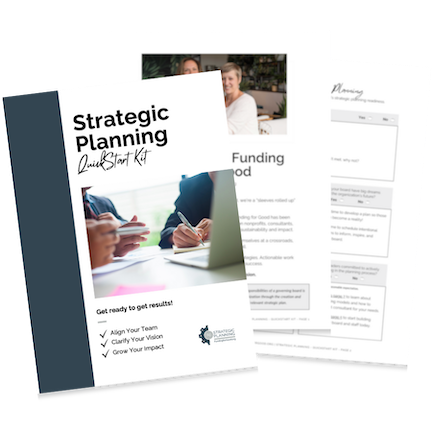Nonprofit capacity building is an evergreen topic for boards and executive directors. Why? Because our organizations are always growing and changing to meet shifting community needs.
Imagine this: Your programs are humming along. Your fundraising is on the rise. Your community is engaged, and your impact is growing. But your staff is increasingly stretched thin, struggling to keep up with your organization’s success. Your databases and other systems might as well be from 1999. And your managers are learning to manage on the fly, meaning staff are getting very different levels of support.
All of this is a sure sign that it’s time to create a plan for capacity building.
Nonprofit capacity building can be an incredible opportunity—but it can also easily be squandered if investments aren’t well targeted. That’s why the biggest question we hear from nonprofits looking to build capacity is:
Where should I invest my capacity building dollars?
Here at Funding for Good, we like to start with a solid foundation. So for our 2023 Webinar Series about nonprofit capacity building, Growing with Intent, our first webinar focuses on Capacity Building Basics.
What Is Capacity Building for Nonprofits?
Funding for Good defines capacity building as:
Nonprofit capacity building is the process of increasing an organization’s ability to fulfill its mission
While the definition of capacity building may sound simple, putting it into practice can quickly become complex. Let’s take a look at how this can play out in real life.
A Classic Capacity Building Scenario
Here’s a common scenario. You’re the executive director of a small to medium-sized nonprofit and it’s your organization’s final board meeting of the year. Everyone agrees the organization’s work and fundraising are going great. Your leadership is commended. But it’s also clear that staff—including you—are struggling under the workload.
Luckily, you’ve raised an extra $100k for the new year, above and beyond your operating budget. Which is great news because it’s the perfect moment to invest in capacity building.
But where do you start?
Your board chair suggests bringing on your first full-time human resources staff member. Your board secretary notes that the outreach team has doubled its reach in the last year and could desperately use a new set of hands. Other board members and senior staff chime in with ideas: hire a communications staff member, bring on a grant writer, set up management and leadership trainings, invest in better IT, including finally updating that clunky old database.
The ideas for where to spend capacity building dollars are endless. And you quickly realize that, if you were to go with everyone’s ideas, the organization’s budget would at least double. That kind of year-over-year growth simply isn’t sustainable. Not to mention you only have $100k allocated for capacity building in the next year.
So you take good notes, thank everyone for their ideas, and tell them you’ll get back to them with a proposed plan at the first quarter’s board meeting.
Then you take a deep breath and delve into figuring out exactly what kind of capacity building investments will help your organization the most.
Nonprofit Capacity Building Examples
As our scenario shows, one of the challenges of nonprofit capacity building is just how many activities can fit under this umbrella. Back in 2001, the Urban Institute explained that capacity building is:
too popular and expansive a term to mean much to individuals making specific decisions about programs and grant strategies.
Twenty years later, that sentiment is often still true today. Luckily, however, we’ve come a long way in understanding what works and what doesn’t when it comes to capacity building.
The most effective nonprofit capacity building is tailored to the unique needs of each organization. Which is why we recommend taking a step back and starting with some basic questions:
- What are your organization’s current pain points? To assess pain points, you may want to meet with department heads, survey staff and other stakeholders, or even join department meetings for a focused discussion. For example, in our scenario above, once you meet with the development team you learn that their donor database is painfully out of date—both in terms of technology and content. To make matters worse, the lack of good data is impacting revenue. While foundation grants have increased, individual donations are down 30% over the last two years. Without investing in a more functional donor database and finding capacity to keep the data up to date, you could be facing a budget shortfall sooner rather than later.
- Where is your organization planning to grow in the next 3-5 years? As much as you want to understand your current pain points, this is also a moment to anticipate future challenges. If you have a strategic plan, this is the perfect time to pull it out and identify your planned growth areas. For example, your strategic plan might call for more investment in communications to raise awareness about the issues your organization works on. While the communications department might be fine on capacity right now, your plan calls for doubling your communications reach in the next two years. If you don’t have a strategic plan, now would be the perfect time to create one.
- What are the costs associated with addressing each of the identified needs? Once you’ve identified your current and future capacity needs, it’s time to understand the costs for each one. For example, if you find that your managers are consistently struggling, how much will a leadership development and management training program cost? Or, if you need to migrate that donor database into a new system, what are the range of prices and features available—and which will best meet your team’s needs? You may find that some capacity building needs can be addressed with relatively affordable one-time costs, whereas others may require significant long-term expenses, such as bringing on new staff members.
Finally, it’s time to sit down with your list and your budget to start prioritizing. The truth is there’s no one-size-fits-all approach to nonprofit capacity building. But understanding best practices—and matching those against your organization’s unique needs and budget—will get you far in creating your capacity building plan.
To learn more about getting started with capacity building, including knowing when it’s time to invest in building capacity, top areas for capacity building, and how to leverage resources to build your organization’s capacity, check out our webinar Knowing When to Grow: Capacity Building Basics.



